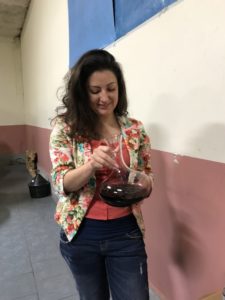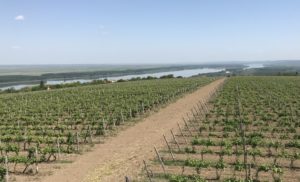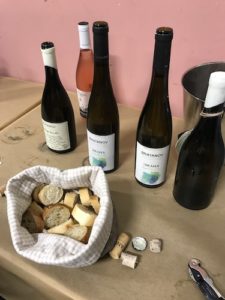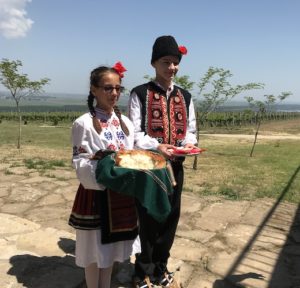The wines of Bulgaria have long been defined by big, bold reds, both traditional varietals such as cabernet sauvignon and merlot, as well as indigenous grapes like mavrud and Melnik. But the country’s fresh, aromatic whites have started to command more attention, as have its more refined, elegant reds and rosés.
The Fine European Wines project, managed by Brand Marketing Organization World Wine and funded by the European Union and the Republic of Bulgaria, hosted a tour for several U.S. wine professionals in 2018. The group visited a number of producers to learn about the country’s unique wine regions and grapes.
A New Era
While Bulgaria has been producing wine for centuries, the country’s modern winemaking industry started only about 15 years ago, says Tanya Avramova, marketing manager for Bratanov Winery in the South Sakar region. And it has progressed quickly just in the past few years in terms of quality and innovation.
Bratanov, established in 2010 by Avramova’s father-in-law and his sons, takes a different approach to winemaking, she notes. For instance, it was the first winery in Bulgaria to do all wild-yeast fermentation. “We want to express the purity of the terroir.”

That’s a far cry from the mass quantities of cheap, mainstream wine made that Bulgaria was known for exporting during its 45 years under Communism. “The Communist wines were a mess of merlot, cabernet…you couldn’t taste the fruit,” says Marin Atanasov, brand ambassador for Brand Marketing Organization World Wine.
Winemakers today are better expressing the terroir and preserving the primary flavor of the grape, Atanasov says. Bulgaria is rediscovering its indigenous varietals and European traditions while embracing modern techniques.
For instance, Bratanov in 2013 worked with winemakers from Hungary and New Zealand for old- and new-world expertise, Avramova says. Bratanov’s head winemaker Maria Stoeva, who joined the company in 2015, studied in Dijon, France and was named Bulgaria’s 2016 Young Winemaker of the Year.

Chateau Burgozone in the Danubian Plain region in Northwest Bulgaria seeks to create wines with elegance, says export director Biliana Marinova. Founded by Marinova’s parents in 2002, Burgozone aims to achieve the three Fs: “finesse, freshness and fruit.”
The winery’s Via Istrum viognier, for instance, is expressive with a crisp freshness, while its sauvignon blanc offers subtle grapefruit flavors and minerality. “It’s a very ‘Burgozone’ style,” says Marinova, halfway between European and New World.
Aromatic whites
While the quality has improved in the past decade, Bulgarian white wine doesn’t yet have an identity, Atanasov notes: “We are developing it.” He has been promoting the country’s aromatic whites for about two years.

Bulgarian winemakers are doing their part. At the Salla Estate Winery, established in 2010 in the North Black Sea region near Varna, winemaker Anelia Hristakieva is known for her expertise with oak. Her 2013 barrel-aged chardonnay, which retails for about $25, was rated the 2017 Best White Wine in Bulgaria by wine publication DiVino.
Hristakieva recently experimented with an oak-barrel-aged riesling, which has been a hit with the local market. She hopes Bulgaria will start producing more riesling and become known for the varietal.
As with the reds, many Bulgarian winemakers have embraced the indigenous white varieties. For instance, dimyat is now coming up as a local grape; it was once primarily used for brandy. Just a few wineries are doing 100% dimyat wines, Atanasov says. Karabunar Winery in Bulgaria’s Thracian Valley is one.

Tamianka, a muscat-like, indigenous grape that was mass-produced for mixing during the Communist years, is now showing up in fine wines. Retailers in the U.S typically put tamianka is the Alsace wine section, Atanasov says, “and it does quite well.”
Bratanov has recently had success with a wild-fermented tamianka, which would retail in the U.S. for about $20. But it was a risky move for the winery to come out with a 100% tamianka, Avramova says.
That’s because the wines previously made from the grape were done a semi-dry style for export to the U.S.S.R. So if people remembered tamianka at all, it wasn’t the same style or quality of wine Bratanov came out with, she adds.
“In the Communist time, they tried to mute the acidity of the wine,” Avramova explains. “People were afraid of acidity in wine—they didn’t realize it was freshness.”
Other aromatic Bulgarian whites include red misket and Sandanski misket, a crossing of tamianka and broad leaf or original Melnik. Salla Estate does a vrachanski misket from an ancient local grape; just four or so wineries in Bulgaria are making this wine, Atanasov says.

Traminer, which in Bulgaria usually means traminer pink rather than gewurtraminer, is also popular. Bulgarians used to believe it was a local grape, but the traminer first came from the Czech Republic, Atanasov says.
Tsarev Brod in the middle Danubian Plain region is the only Bulgarian winery producing the white wine gerganna. A hybrid of muscat ottonel and local dimyat, gergana was developed in 1972 as a late-ripening grape with high acidity, says Tsarev Brod winemaker Nikolay Krastev.
Rosés and reds
In addition to its signature red-wine grapes mavrud, gamza, pamid, broad leaf Melnik and Melnik 55 (also known as early Melnik), Bulgaria boasts a number of unique red hybrid grapes. These include rubin (syrah and nebbiolo), evmolpia (mavrud and merlot) and melnishki rubin (rubin and cabernet sauvignon).
The style of Bulgarian reds tends to be big and overblown, but there is a movement of making more precise and elegant wines. For instance, Salla Estate has a red blend of 70% cabernet franc and 30% pinot noir that’s produced with little oak for a fruit-driven wine that’s meant to be consumed young and enjoyed with food.
The rosé at Salla is always a blend of cabernet franc and pinot noir, as those are the only two red grapes it grows. Usually the cabernet leads, but the winery recently did a vintage in which the two grapes were 50-50, resulting in a drier, more herbal style of rosé.
Bratanov Winery started experimenting with a small amount of rubin in 2013, and is passionate about the grape, Avramova says. Syrah is also a promising red variety for the region, she adds. The winery’s South Sakar Collection is always a blend of syrah and merlot.
Bratanov produces a Symbiose rosé made from 85% merlot and 15% syrah. The winery also has a barrel-aged rosé of syrah that’s more like a light red wine, Avramova says. “We don’t want to make Provence-style rosé.”
Tradition and Trends

Bulgarian winemakers are experimenting with grapes and blends to create their own style and redefine the industry, balancing the traditional and the trending.
Villa Melnik, a family winery in the Strouma River Valley in southwest Bulgaria, came out with an orange wine about three years ago. The 100% sauvignon blanc wine is made like a red, with limited skin contact.
“People in Bulgaria want something new and different, but also something that they understand,” says sales and export director Militza Zikatanova.
Villa Melnik, opened by Zikatanova’s parents in 2013, is not surprisingly focused on Melnik grape wines, as well as other indigenous varieties. “We think local grapes are the future” of Bulgarian wines, Zikatanova says, “sometimes blended, sometimes on their own.”
Melissa Dowling is editor of our on-premise sister publication Cheers magazine. Reach her at mdowling@epgmediallc.com.









